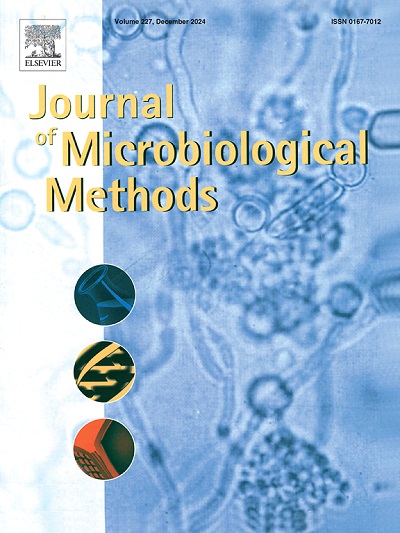Characterization of circulating Mycoplasma hyopneumoniae variants in the Midwestern United States using Multiple-Locus Variable number tandem repeat Analysis and P146 gene sequencing
IF 1.7
4区 生物学
Q4 BIOCHEMICAL RESEARCH METHODS
引用次数: 0
Abstract
In the United States, Multiple-Locus Variable number tandem repeat Analysis (MLVA) and complete P146 gene sequence are employed to characterize Mycoplasma hyopneumoniae from clinical samples. However, a comparison of MLVA and P146 sequencing and interpretation of assay results has not been conducted. Therefore, the aim of this study was to characterize and compare M. hyopneumoniae variants detected in the Midwestern United States using MLVA and P146 gene sequencing. A total of 160 samples were analyzed for this investigation. Both molecular techniques were compared for assay sensitivity, discriminatory power, and congruence. Epidemiological relationships in clustering of M. hyopneumoniae variants were evaluated employing Principal Coordinate Analysis. Fair agreement (κ = 0.34) in assay outcome was calculated between the two techniques. Ability to obtain a VNTR type or a P146 sequence was dependent upon the relative bacterial load (i.e., Ct value) in the sample. Simpson's diversity index was higher for MLVA (D = 0.899) than for P146 sequencing (D = 0.844). High congruence for the number of tandem repeats detected in the poly-serine region of P146 was also obtained. Similar epidemiological inferences were generated from the two assays, as production flow explained most of the variation in the clustering of VNTR types and P146 sequences. Results from this study highlighted differences in sensitivity and discriminatory power between the two molecular techniques. Nevertheless, both techniques revealed a wide genetic diversity among M. hyopneumoniae variants, with similar epidemiological inferences generated. Further research utilizing whole-genome sequencing could help identify other areas within the genome that are unrepresented by MLVA and P146 sequencing, can aid characterizing M. hyopneumoniae variants.
利用多位点可变数串联重复序列分析和P146基因测序对美国中西部流行肺炎支原体变异进行表征。
在美国,采用多位点可变数串联重复分析(MLVA)和完整的P146基因序列来鉴定临床样本中的肺炎支原体。然而,MLVA和P146的测序比较和分析结果的解释仍不清楚。因此,本研究的目的是利用MLVA和P146基因测序来表征和比较在美国中西部检测到的肺炎支原体变异。本次调查共分析了160份样本。比较两种分子技术的检测灵敏度、鉴别能力和一致性。应用主坐标分析评价猪肺炎支原体变异聚类的流行病学关系。两种方法的分析结果相当一致(κ = 0.34)。获得VNTR型或P146序列的能力取决于样品中的相对细菌负荷(即Ct值)。MLVA序列的Simpson多样性指数(D = 0.899)高于P146序列(D = 0.844)。在P146的多丝氨酸区检测到的串联重复次数也获得了高一致性。从这两项分析中得出了类似的流行病学推断,因为生产流程解释了VNTR类型和P146序列聚类的大部分差异。本研究的结果突出了两种分子技术在灵敏度和鉴别能力上的差异。然而,这两种技术都揭示了肺炎支原体变体之间广泛的遗传多样性,并产生了类似的流行病学推断。利用全基因组测序的进一步研究可以帮助鉴定基因组中MLVA和P146测序未代表的其他区域,但可以帮助表征肺炎支原体变异。
本文章由计算机程序翻译,如有差异,请以英文原文为准。
求助全文
约1分钟内获得全文
求助全文
来源期刊

Journal of microbiological methods
生物-生化研究方法
CiteScore
4.30
自引率
4.50%
发文量
151
审稿时长
29 days
期刊介绍:
The Journal of Microbiological Methods publishes scholarly and original articles, notes and review articles. These articles must include novel and/or state-of-the-art methods, or significant improvements to existing methods. Novel and innovative applications of current methods that are validated and useful will also be published. JMM strives for scholarship, innovation and excellence. This demands scientific rigour, the best available methods and technologies, correctly replicated experiments/tests, the inclusion of proper controls, calibrations, and the correct statistical analysis. The presentation of the data must support the interpretation of the method/approach.
All aspects of microbiology are covered, except virology. These include agricultural microbiology, applied and environmental microbiology, bioassays, bioinformatics, biotechnology, biochemical microbiology, clinical microbiology, diagnostics, food monitoring and quality control microbiology, microbial genetics and genomics, geomicrobiology, microbiome methods regardless of habitat, high through-put sequencing methods and analysis, microbial pathogenesis and host responses, metabolomics, metagenomics, metaproteomics, microbial ecology and diversity, microbial physiology, microbial ultra-structure, microscopic and imaging methods, molecular microbiology, mycology, novel mathematical microbiology and modelling, parasitology, plant-microbe interactions, protein markers/profiles, proteomics, pyrosequencing, public health microbiology, radioisotopes applied to microbiology, robotics applied to microbiological methods,rumen microbiology, microbiological methods for space missions and extreme environments, sampling methods and samplers, soil and sediment microbiology, transcriptomics, veterinary microbiology, sero-diagnostics and typing/identification.
 求助内容:
求助内容: 应助结果提醒方式:
应助结果提醒方式:


